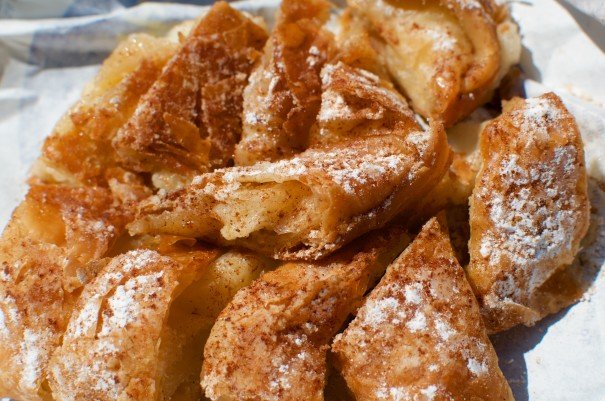
A Humble Reminder of a City and Safe Haven

A Humble Reminder of a City and Safe Haven
Bougatsa in Thessaloniki
I don’t usually eat much pastry. Croissants (even Parisian ones) leave me cold, strudel doesn’t appeal; I generally favor a crustless quiche. But if you’re in Thessaloniki and you’re not eating at least one pie a day—ideally one pie per meal—then you’re doing it wrong. Pastry proliferates across Greece’s second city. Glass cases of pies, oozing unctuous fillings from between crackling sheaves of filo, tempt passers-by on each corner. Spirals and slabs, triangular wedges and bulging half-moons; soft mouthfuls of spinach, feta, leek, onion securely encased in bronzed layers of butter and flour. Any one of those will make a serviceable—nay, sumptuous—lunch. Only bougatsa will do for breakfast.
The name itself dances on the tongue like an onomatopoeic expression of joy: an exclamation of surprise elegantly sling-shotting itself forward, through twanging consonants, into the satisfied sigh of the final vowel. Boo-gat-saaaaahhh. Peer in the cabinet. It doesn’t look like much, especially at this stage: a flat, flaking slab of filo. Even when prepared—one generous square sliced deftly into many smaller squares (a raised eyebrow from the mezzaluna-wielding assistant, and the arch enquiry, “only one portion?”), the resulting golden rubble softened by a swift squall of icing sugar and cinnamon—its bland, burnished exterior remains deceptive. Take a bite. That flaxen façade hides moist inner layers, lovingly clasping a voluptuous semolina-custard core.
I eat my first helping of bougatsa (a still-warm clutch of bite-size morsels; mellow vanilla filling bolstered and balanced by the salt-flecked crunch of the filo) by hand from the packet, sitting at the top of a small flight of stairs that cuts irreverently through a section of Thessaloniki’s Byzantine walls. Elderly Greek women, passing warily, witness my al fresco gluttony with mild consternation.
Below, the town tumbles to the edge of the Thermaic Gulf, across which hover the snow-shrouded slopes of Mt Olympos. This location—at the foot of the Balkans, on the watery intersection between east and west—has historically rendered the city a place of sanctuary and exchange. Amongst the concrete apartment blocks of the modern centre nestle the bones of bygone eras: austere outcrops of Byzantine churches; the odd, tatterdemalion Ottoman mosque; an all-but-forgotten 1920s synagogue, lonely remnant of a once-flourishing Sephardic community.
Northern Greece’s bougatsa, like its buildings, is a product of the diverse milieu—Jewish, Christian, Muslim—that characterized Thessaloniki up until the mid 20th century. Salonica has long been a city of refuge; while under Ottoman rule, the city opened its arms to exiles from east and west. Sephardic Jews, expelled from Western Europe by Ferdinand and Isabella’s anti-Semitic decrees, surged into the city from the late 15th century. In the early 1900s, Judeo-Spanish-speaking Jews made up almost half the city’s entire population; the remainder was a heterogeneous mix of Greeks, Slavs, Ottoman Turks, Circassians, Armenians, Russian Ashkenazim, Georgians, Kurds.
Bougatsa likely joined this cosmopolitan brew from the east—it may even be a modern iteration of the Byzantine “santé bougatsa,” described by 17th century traveller Evliya Çelebi as a sweet pie sprinkled with sugar and sold by street vendors in Stamboul. A descendant of that ancient sweetmeat, legend has it, was carried into Thessaloniki by the flood of Greeks who poured into the country in the early years of the 20th century: Orthodox Christians driven from the Ottoman Empire as the power of the Sublime Porte imploded.
Reports of that mass migration could just as accurately depict the refugee crisis that currently grips the region. Ernest Hemingway, writing in the Toronto Star in 1922, described “exhausted, staggering men, women and children, blankets over their heads, walking blindly along in the rain beside their worldly goods.” Many of the displaced settled in Salonica, filling a vacuum left by the city’s Muslims, who had set sail for Turkey. They brought with them a rich culinary tradition, and, perhaps, a recipe for semolina-custard pie. Bougatsa is a humble reminder of the city’s historic role as safe-haven, at a time when Greece is yet again at the forefront of a historic exodus.
An object lesson in tolerance (however fragile or conditional), maybe—but the pastry is also a powerful trigger for more primal reveries. Like Proust’s madeleine, bougatsa is a repository of personal, as well as collective, memory. Crunching through my portion, sitting on sun-warmed stone in the crook of the ancient walls of an unfamiliar town, I am transported back to my own childhood: the melk tert my mother used to make. A South African specialty, that pie—egg custard in a shortcrust shell—owes its milky, cinnamon-sprinkled charm to an equally unlikely confluence of cultures: the Cape’s distinctive combination of lactose-loving Dutch settlers and their spice-savvy Javanese slaves.
People move, this pre-noon pie-induced reverie reminds me—whether by choice or necessity, out of force or free will—and food moves with them: out of history, into the hard-won, hybrid present.